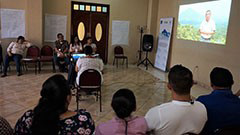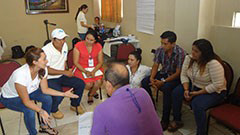Utilize as an essential material in the project

The training program in San Miguel, on Sept. 27, 2018. We screened "The Lessons from Livelihood Improvement Experiences in Postwar Japan" in this program
JICA has been conducting "Project for Strengthening of Local Capacity to Promote Local Development with the Life Improvement Approach in the Eastern Region" (Japanese) in El Salvador. Watching JICA-Net multimedia-based learning material "The Lessons from Livelihood Improvement Experiences in Postwar Japan" is placed as one of the training programs against Municipal Social Promoters and rural people in this project.
Up to the present, on 2018, 26 Municipal Social Promoters and 280 leaders and rural people who came from 7 communities in 6 municipalities watched the material. And on 2019, 8 Municipal Social Promoters and 360 leaders and rural people who came from 9 communities in 7 municipalities watched the material, too.
Meanwhile, Social Investment Fund for Local Development (FISDL), which is counterpart in this project, has been conducting "Project for Strengthening of the Capacity of Municipalities to Manage and Implement Social Development Programs with the Livelihood Improvement Approach" with their own budget since 2015. In this project, Livelihood Improvement Extension Workers [1] and rural people are also required to watch this material. FISDL reports 74 Livelihood Improvement Extension Workers and 6492 residents watched the material and they try "Livelihood Improvement" in 24 municipalities in El Salvador by October 2019.
Make use of Japanese experiences to livelihood improvement in developing countries
We can take the livelihood improvement as the movement that became the basis of rural democratization in postwar Japan and improved rural living standard very much. "The Lessons from Livelihood Improvement Experiences in Postwar Japan" (external link) overlooks Livelihood Improvement Movement and shows this movement in postwar Japan would give some suggestions and lessons for developing countries' assistance in the present. This material is designed to deepen the understanding through example cases based on 5 key ideas; farm village development, poverty reduction, production activities compatible with the target group's lifestyle, participatory development, and synergic relationship between the local administration and the villagers.

Japanese kitchen of rural area in 1940's, which was dark and very humid. Livelihood Improvement Movement began with hearing women in community
After watching the material, the participants in the program will discuss about the contents and look back their life to find something to improve. Also when the trainees make a report of JICA Knowledge Co-Creation Programs "Life Improvement Approach for Sustainable Rural Development in Latin America Extension and Extension Training Methods" which they participated, they used the material in their own city office, too.
To raise residents' consciousness
FISDL is the implementing entity of the social development program in El Salvador and strengthens efforts against rural development. FISDL has strongly recognized a necessity of their consciousness improvement against the local government and residents that they depend on assistance from domestic and overseas for many years constantly, and has been looking for the effective and necessity supporting way for realization that it will free the local government and residents from their lifelong dependence.
In this background, FISDL is promoting "Life Improvement Approach" which focuses on transforming their way of thinking from inside mainly, not as the way of assistance through calculating poverty reduction by income as ever.
However, rural people are not able to understand immediately no matter how much FISDL explains the importance of "Life Improvement Approach". The reason is that the thought of "Life Improvement" is far from theirs. This material shows Japanese local rural people improved the quality of their life by utilizing their surroundings resources in postwar Japan when they didn't have anything compare to current residents in rural area in El Salvador today. By watching the material, rural people have confidence that they are able to improve their life by local resources.
The view from the position conducting a training program

The discussion among trainees after watching the material
JICA-Net multimedia-based learning materials is not only the useful contents but also the excellent tool which help us to conduct a training program smoothly and effectively. For example, Japan Overseas Cooperation Volunteers who engaged in community development and don't study local language enough yet and have little experiences of facilitation, screening the materials is very helpful to activate discussion among trainees like we use in our project. We should be able to make good use of those materials in several cases by utilizing approachable contents with advantage of understandable and summarized visual media or various language version.
KUWAGAKI Ryuichi
JICA El Salvador Office
Note
[1] Municipal Social Promoters are officers, and Livelihood Improvement Extension Workers are employed by budget distributed to city from FISDL. Livelihood Improvement Extension Workers facilitate rural people to get involved in Livelihood Improvement activities. Municipal Social Promoters support to make rural development plans and carry out them in the area where rural people already learned thought of "Life Improvement".
*The Material(s) mainly applied
The Lessons from Livelihood Improvement Experiences in Postwar Japan
This material was made for Japanese organizations that help developing countries as a reference for their assistance work. Currently, in each livelihood improvement project, there is a tendency to introduce improved kamados, as just an input activity, without considering the social context, and handicraft or food processing are introduced as a livelihood improvement project just because income improvement is the main objective. Therefore, this material is designed to deepen the understanding through example cases based on 5 key ideas: farm village development, poverty reduction, production activities compatible with the target group's lifestyle, participatory development, and synergetic effects between administrations and residents.




scroll